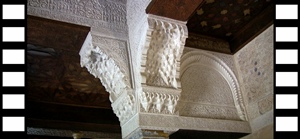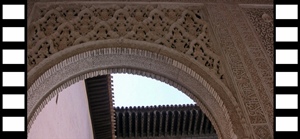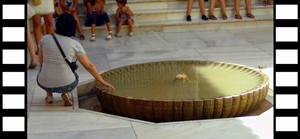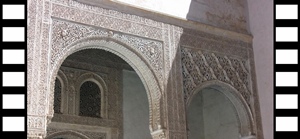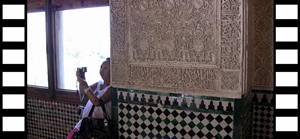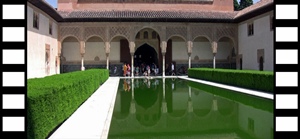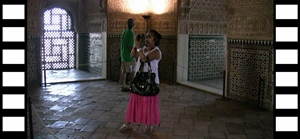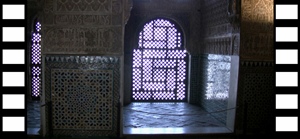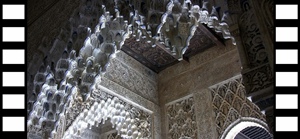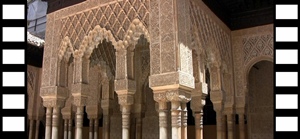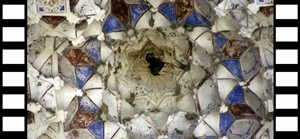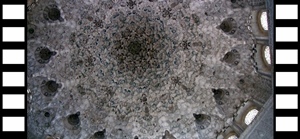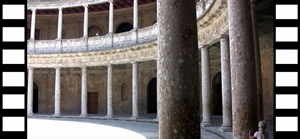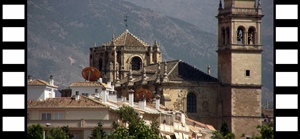After a short wait at the gathering spot, someone came and got us, and we were escorted to the entry of the first
of the Nasrid palaces, the Mexuar Palace. The Mexuar Palace is believed to have housed the royal court of justice
for the Nasrids. It was substantially altered by the Christian monarchs to hold a chapel. The palace's oratory
suffered significant damage from a gunpowder explosion in 1590 and was not fully restored until 1917.

Bob and Entry to Hall of the Mexuar

Detail Above Entry

Crown Above Entry, Interior

Crown, Wall and Column
Mihrab (Devotional Arch), Oratory
The Mexuar courtyard is surrounded on one side by a room called the Golden Chamber and on the other by what is
called the façade to the next palace, the Comares Palace.
Nella with Façade of Comares Palace

Arch and Façade of Comares Palace

Comares Façade, Bob and Courtyard

Nella and Golden Chamber Portico

Nella on Portico

Arch, Golden Chamber

Portico Column, Golden Chamber

Nella Inside Golden Chamber

Ceiling, Golden Chamber
The Comares Palace surrounds a large courtyard with a long, rectangular reflective pool, called the Courtyard of the Myrtles.

Archway, Comares Palace

Niche, Comares Palace

Courtyard of the Myrtles with South Gallery

Tile and Decoration, South Gallery

Courtyard of the Myrtles with Comares Tower

Courtyard of the Myrtles with Comares Tower
At one end of the courtyard is a room called the Hall of the Ambassadors, used as the throne room, and a sort of
antechamber called the Hall of the Boat. As in the rest of the palaces, the decorations are in the mudejar style
rather than a pure Arabic style, partly because of the isolation of Al-Andalus from the rest of the Muslim world
since the declaration of the Caliphate and partly because of interactions with Europeans representing different
architectural influences. The decorations are characterized by painted tiles and densely detailed inscriptions
of calligraphy (usually Koranic verses), foliage-inspired patterns (known as arabesques) or geometric
patterns. An Islamic principle known as aniconism, practiced to greater and lesser extents by different
Muslims, forbids the depiction of humans or other sentient creatures.
Façade and Portico, Hall of the Boat

Portico, Hall of the Boat

Nella with Hall of the Ambassadors

Hall of the Ambassadors

Hall of the Ambassadors

Hall of the Ambassadors

Niche, Hall of the Ambassadors
A small door on the side of the courtyard led to the next palace, the Palace of the Lions. The Palace of the Lions
is named after the fountain at the center of its courtyard, which is surrounded by twelve stylized lions which
spew water from their mouths. We'd love to show you a picture of it, but it was under restoration during our visit
and hidden from view. But there was plenty to see anyway. The courtyard is surrounded by columns, with small
projecting pavilions at the east and west ends.

Nella and Courtyard of the Lions

Courtyard of the Lions

Courtyard of the Lions

Courtyard of the Lions

Courtyard of the Lions

Courtyard of the Lions
Ceilings and archways in the palace itself show examples of a feature known as mocarábes. It is said that
Mohammed received inspiration for the Koran in a cave in which he was hiding from pursuing enemies. Mocarábes
are combinations of a great number of small, simply-shaped stucco elements to produce a resemblance to the ceiling
of such a cave, including stalactites.

Hall of the Abencerrages

Ceiling, Hall of the Abencerrages

Alcove, Hall of the Abencerrages

Hall of the Abencerrages

Hall of the Two Sisters

Arch, Hall of the Two Sisters
From the Palace of the Lions we passed through a courtyard called the Courtyard of Linderaja and an arcade with a nice
view of the Albaicín neighborhood across the ravine to the north, and found ourselves exited from the palaces.

Courtyard of Lindaraja

Fountain, Courtyard of Lindaraja
View from Peinador de la Reina
We continued eastward an found another structure, called the Tower of the Ladies, which seems to be a sheltered viewpoint
with a large pool in front of it.

View from Tower of the Ladies

Tower of the Ladies

Bob and Pool, Tower of the Ladies

View of Wall
From here we walked along the outer wall a little more and eventually backtracked through the gardens, starting on a
search for lunch. This search proved to be unsuccessful – there is surprisingly little real food (as opposed to snack
food) to be had in the Alhambra complex. We found a cafeteria, but they were closing when we got there, so we decided
to find food in town on our way out. We'd last eaten in Seville several hours earlier, so our stomachs were
growling. Nevertheless, we stopped for a quick look at the Palace of Charles V, the square 16th Century stone behemoth
south of the Nasrid palaces which turned out to have a big circular courtyard. And a quick look was all that was really
necessary – while impressive, the palace looked pretty much the same from all angles, though we did go upstairs to check
out that vantage point.
Palace of Charles V (Palacio de Carlos V)

Courtyard from Lower Level

Lower Colonnade

Palace from Lower Level

Courtyard from Upper Level
We discovered a museum housed in the palace, with admission included in the Alhambra ticket price, so we quickly made
our way through it, with nothing really grabbing our attention. This may have been more a reflection of our state of
starvation than the museum itself, but I don't really remember much about it so I couldn't say for sure.
We exited the grounds through the Justice Gate, just south of the Charles V Palace, and found a bus stop across from
the gate. We had some time, so we took pictures of the Charles V Fountain (1543) next to the gate while we were
waiting.
Charles V Fountain (1543)
We got off the bus in the Plaza Isabel la Católica and walked uphill in search of a restaurant, successfully finding
one on the left side of the street. We were the only customers, the hour being on the weird side, but we were grateful
to finally be able to feed ourselves.

Fountain, Plaza Isabel la Católica

Cathedral
After lunch we didn't have too much time before the departure of our train back to Seville, so we just got on a bus
and headed back to the station.

Granada and Mountains from Station

Cathedral from Station
Our return to Seville took a little less time than our trip out, but still exceeded three hours.

Spanish Countryside

Rock Formation
We figured out how to get a bus back to somewhere near our hotel from the station and went looking for dinner, which
turned out to be a small, so-so meal consisting of greasy tapas. Worn out, we returned to the hotel and collapsed.




